Nepal. The very murmur of this landlocked country’s name elicits images of haggard mountaineers practically dragging their weary and oxygen deprived bodies up the Himalayas for that view of Everest, or even Annapurna. Home to an incredible eight of the world’s 14 highest mountains with their craggy peaks seemingly reaching the heavens at over 8000 meters high, this was the picture I had in my mind anyway. That is, until I myself became one of the more than 200,000 trekkers that head to Nepal for an adventure every year. It wouldn’t be Everest Base Camp or the Annapurna Circuit for me, two of Nepal’s most famous and popular treks. Instead, I dipped my toe in to Nepal trekking with the 4-day Ghorepani Trek in the foothills of Annapurna.
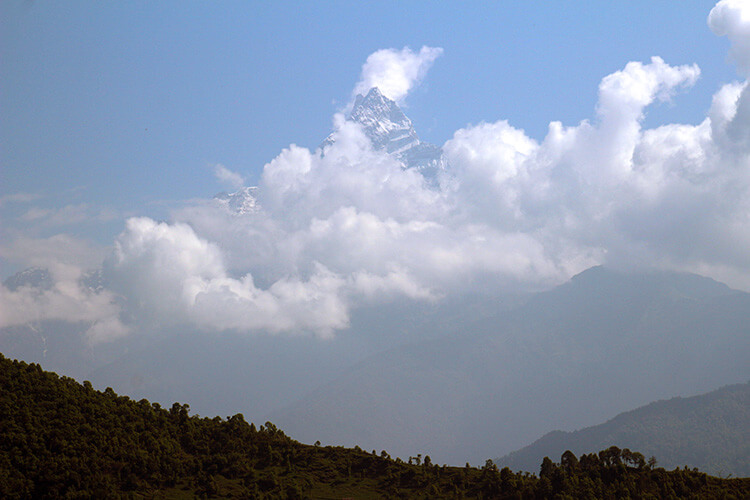
Machapuchare, also known as Fishtail, peeks out of the clouds during one of the clearest views I had
The Ghorepani Trek
Also known as Poon Hill, the Ghorepani trek is typically a 5-day trek (though we did it in four) that climbs to 3210 meters to the Poon Hill viewpoint for a panoramic view over the Annapurna Mountain Range. The highlight is the sunrise from Poon Hill kissing the Annapurna Range in a golden glow.
It’s a loop, offering differing views, vantage points and terrain throughout the entire ~60 kilometers. And the trail is accessible year-round, though the best time to trek Ghorepani is in October to November.
The trail traverses through mountain villages (Nepalis call these hills, but at nearly 11,000 feet they certainly qualify officially as mountains), making Ghorepani an excellent introduction to multi-day long distance trekking in Nepal. The trek is perfect for the average traveler who can’t take several weeks off work to complete the 2-week Everest Base Camp and Annapurna Circuit treks.
Day 1: Naya Pul (1060 meters) – Tikhedhunga (1540 meters)
I knew very little about Nepal before my 2-week visit. My only knowledge came from reading Into Thin Air and watching movies like Touching the Void and Everest. I, like several others visiting Nepal with Himalayan Travel Mart and PATA for this trip, had the impression it would be cold.
I even checked the mountain forecast for a full week leading up to my departure, and it had appeared I’d be trekking in relatively comfortable temperatures ranging from 59° – 72° Fahrenheit. Only the night we would spend in the high Ghorepani village would get close to freezing.
And based on my experience hiking from Flagstaff up to the 10,418 feet summit of Kendrick Peak, I had the impression that I would be cool and comfortable. Maybe even cold at times.
Holy hell, was I ever wrong.
The moment I stepped out of the plane in Kathmandu, it brought back the days of stepping outside in Phoenix in summer. Like a hairdryer blowing hot air at you.
Only now I was in Nepal. And the spinning dirt devils that blew across the sandy desert of the nature reserve our house sat on the edge of in Phoenix were replaced with dust clouds kicked up, first by the constant buzz of motorbikes in the city’s dusty streets, then by the packs of mules clomping up and down the trail.
I huddled under the shade of the small roof that jutted out from the tea house where our porters and guide met our small group in Naya Pul. With the drive there from Pokhara, it was already late morning and blazing hot.
With not a sliver of shade to be found and the temperature already over 90° Fahrenheit, our group set out trekking down through the village of Naya Pul. It was a gradual slope down to the river, but barely 20 minutes later buckets of sweat were already pouring off me as I trudged across the first of a handful of suspension bridges we’d cross over the next few days.
The first day’s trail wasn’t particularly strenuous. It sloped up and down as we made our way along a gurgling river and through tiny villages.
But it was so bloody hot.
I was falling behind most of our group of nine. I’d only been walking for an hour and a half, and I really wondered what I’d gotten myself in to. I was ready to pass out from the heat. The first day had barely begun and this was supposed to be the easy day. As I trudged on by myself for a while, I really started to doubt that I had made a good decision to come trek in Nepal.
I slowed to match my pace to my new friends, Swati and Abhinav, who were walking with two of our guides. A few of the many dogs that would fall in to step throughout the next few days, ran along with us for a while.
I was distracted from just how hot I was by the conversation, and nature.
By far, the oddest thing I saw was a fairly large crab that came crawling down the trail. We were in landlocked Nepal and not even near a river. How it got there was beyond all of us, and our Nepali guides said they’d never seen a crab before. It was certainly a much more welcome sight than the leopards and Bengal tigers I’d be regaled stories of encounters with as we trekked on.
The tea house where we stopped for our lunch was an incredibly welcome sight as we finally reached it about four hours after we left Naya Pul. I practically collapsed in a chair at the table.
I was so hot, I just wasn’t even really hungry.
As we readied ourselves to trek the next two more hours to the tea house where we’d spend the night in Tikhedhunga, the skies opened up and the rain came down hard and fast. Waiting it out for a few minutes, the rain slowed and we set off.
It continued to rain on us for the rest of the day’s trek, but it dropped the temperature by at least 20 degrees. Everyone else donned raincoats; I, meanwhile, let it soak me down and cool me off. It felt refreshing, really.
I had stashed my camera in the dry bag I’d smartly packed and then secured it inside my waterproof backpack and covered it with the rain cover. Unfortunately, my camera would spend a lot of time in that dry sack during the 4-day trek.
Length: 13 kilometers
Duration: 6-7 hours
Recommended tea house for lunch: Mountain View Lodge in Ramgai
Recommended tea house for overnight stay: Laxmi Guest House in Tikhedhunga
Day 2: Tikhedhunga (1540 meters) – Ghorepani (2900 meters)
The second day was the one I was dreading from the moment I received my itinerary. Anything you can find online about the Ghorepani trek will profess that the trek from Tikhedhunga to Ghorepani is by far the hardest section.
We knew we’d face an upward climb on slate stairs as we gained 1387 meters of elevation.
Never ending stairs. The locals say there are 3767 of those slate stairs. I resolved myself to never try and count. It was already an uphill battle without knowing you’d only tackled a few hundred of what already felt like thousands. But someone else did keep count and she claims there were over 7000.
What’s the real number? I’ll never know. But I know this: my legs were like jello by the end of the day.
From Tikhedhunga, we dropped down and crossed another suspension bridge over cascading waterfalls to Bhurungdi Khola. It’s here that the infamous stairs begin. And you climb, climb, climb with no end in sight until you reach Ulleri.
At first, every time I turned around to take in the steps I’d just climbed, I was met with misty views of terraced villages. Corn seemed to be the crop of choice.
As we climbed, the Annapurna range finally began to reveal itself. It would be some of the only views of the Himalayas we’d get during a pretty rainy four days. And the moments that the snowy Annapurnas did peek out of the clouds were truly spectacular. Those snowy peaks, some of the highest in the world, were a reminder of why I signed up for this trip.
If you ever spot a view that you think is photo worthy, take the photo. There was one incredibly clear moment when even the famous Machapuchare (Fishtail), which is banned to climbing because it is too technically difficult, stood out against the cloudless blue sky. But I was promised an even better view from Ulleri, just 15 minutes away.
Now I wonder if that view wasn’t a dream, because 15 minutes later when we reached the tea house in Ulleri clouds had rolled in and hidden the Annapurnas.
After Ulleri, we left the villages drying onions in the sun and the terrain changed to tree covered jungle. It was here that our guide, Prasan, began explaining what we should do if we met a Himalayan black bear. They’re found from 3000 to 3600 meters at this time of the year, when it’s so hot that they go higher to the top of the timberline.
I secretly wished we would meet one, at least close enough for a photo but still far enough away not to pose a danger to us. We never did though.
We reached the lunch tea house just as the rain came.
The thing I was most worried about doing this trek also happened. I’ve been battling plantar fasciitis for more than five years now, and the strain in my calves really was causing a lot of pain in my left heel. I tend to walk a bit on the side of my foot, as the wearing down on my heels on my shoes always indicates, and I was developing a blister.
I put one of the blister plasters over it, hoping to keep it from getting worse.
The blister soon became the least of my problems as I trudged on upward through the rain. My left foot began having spasms and my toes were curled up like the talon of a bird of prey. Each step became excruciating and we were still an hour or so from the night’s lodge.
Prasan had me sit and he pulled off my shoe to massage my foot and try to get it to relax.
As Swati and Abhinav stood watching, poor Swati was also experiencing a horrible stomach cramp. Meanwhile, the leeches we’d discovered love the wet jungle seemed to quite literally rain from the sky.
One landed and quickly attached itself to Abhinav’s wrist. My massage was halted to quickly attend to its removal. Another leech fell from God only knows where and landed on my bare arm. I quickly flicked it off before it could attach and suck my blood like a wriggling little vampire.
Between the leeches, rain, heel pain and stinky landmines of mule poop, the next hour was pretty much hell. I could have practically kissed the arches of the sign welcoming us to Ghorepani, but I paused only long enough to snap a photo and move on. My goal was to plant myself in a chair once we reached the lodge and not move for a good couple of hours.
And that is exactly what happened. My foot was in bad shape by the time we reached the Hotel Hill Top.
One of my fellow trekkers, Mark, was kind enough to massage my foot for quite some time. It kept having spasms and cramping up into grotesque formations. Then one of the villagers who (genius!) offers massages to weary trekkers arriving at Ghorepani, expertly massaged both feet and lower legs for another hour. It was the best $10 I ever spent.
Length: 17 kilometers
Duration: 10 hours
Recommended tea house for lunch: Green View Lodge in Nangethanti
Recommended tea house for overnight stay: Hotel Hill Top in upper Ghorepani village
Day 3: Ghorepani (2900 meters) – Poon Hill (3210 meters) – Tadapani (2600 meters)
I set the alarm for 3:30am, as the day’s plan was to be out the door to begin the trek to Poon Hill starting at 4am. The sun would rise at 5:15am and we needed to reach the view point before then.
As I rolled over to hit the snooze for 10 more minutes before I pulled myself out of my sleeping bag, I heard the consistent patter of rain on the windows. A few minutes later, our guides made the rounds to let us know we wouldn’t be making the trek up to Poon Hill. The weather conditions were just too bad and we wouldn’t have a sunrise or a view.
Part of me was disappointed. This was the viewpoint this entire trek is based upon. It’s also one of the most famous viewpoints in all of Nepal. I hadn’t suffered with my foot and trekked all this way not to see it.
The other part of me was relieved. We still had two days of trekking to get through, and I was still in pain even though I’d been popping Advil like Tic-Tacs and had a good eight hours off my feet.
Even without the additional 2-hour hike up to Poon Hill and back, the day is a long one covering 15 kilometers.
The rain eventually let up and stopped just in time for our group to start our day. But it left the trail a muddy and puddled mess. In other words, a haven for the ruthless leeches that even seemed to find their way inside our pant legs we’d now begun tucking inside our socks as an extra deterrent.
The trail from Ghorepani in the direction of Tadapani immediately climbs up another long set of slate stairs our group quickly dubbed the Stairway to Heaven. Like the song by Led Zeppelin, they seemed to go on forever.
Once we reached the top, the Himalayas made another of their rare appearances on our trek. The peaks teased us popping out just above the cloud line, almost making you question if they really were white mountains or simply more clouds.
The third day was my favorite day for the scenery, temperature and actual ease of the trail. We climbed just a bit more past some grazing water buffalo, before reaching the highest point we’d reach on the trek.
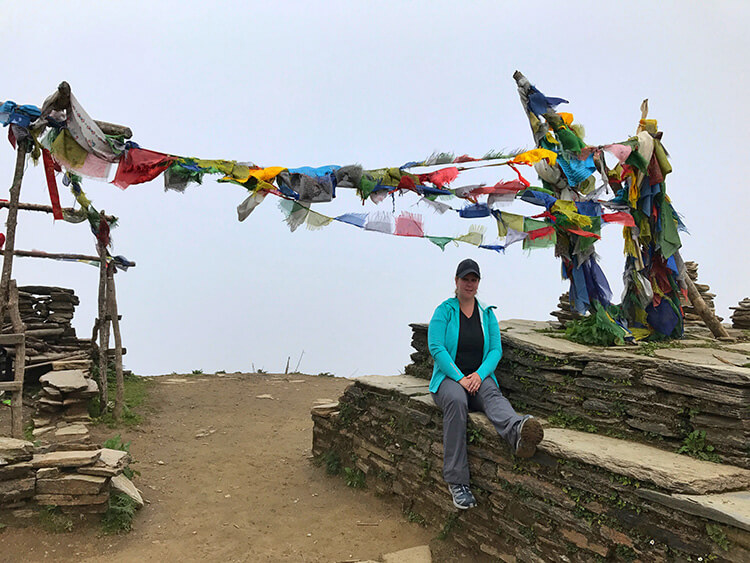
We descended a bit into a misty forest; an almost eerily quiet place as the thick cloud filled the space between the trees.
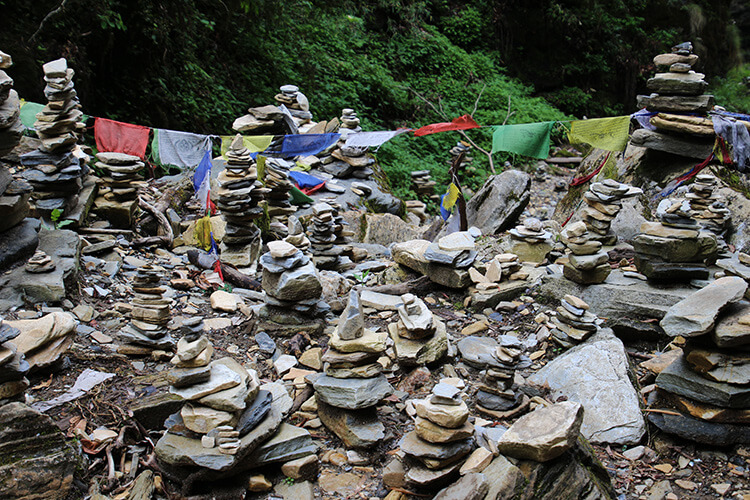
We even spotted processionary moth caterpillars with 43 of them moving in a nose-to-tail train. They get their name because when they leave the nest, they do so in a procession to find an underground location to burrow in to where they will become moths. We watched the phenomenon, similar to ants following one another to their mound, for 10 minutes or so as they inched along the forest floor.
I may not have ever had the encounter with the Himalayan black bear I had hoped to spot, but we did see a troop of gray langur monkeys swinging, playing and eating in a tree. They had a baby, but kept it quite well protected and hidden mostly out of our view.
The last 45 minutes or so of the day’s trek to Tadapandi was the toughest part of the day, as we climbed straight up to reach the tea house we would sleep at. More slate stone steps quickly turned into hap-strewn boulders that I practically needed a boost to step on to. It was almost like an angry Zeus had flung them from the sky and the Nepalis declared them good enough to be fit for a trail.
I was never so happy to finally see the powder blue roofs typical of a tiny village come in to view.
Length: 15 kilometers
Duration: 8 hours
Recommended tea house for lunch: Tranquility Lodge in Banthanti
Recommended tea house for overnight stay: Fishtail Lodge in Tadapani
Day 4: Tadapani (2600 meters) – Kimche (1640 meters)
The second day was the day of my nightmares before actually starting the Ghorepani trek. The last day trekking from Tadapani to Kimche, with a decent of nearly 1000 meters in a relatively short 12 kilometers, is the day of my nightmares now that I’ve completed the trek.
I was moving pretty slow by the last day with my foot never really recovering from all the miles I’d put on it and the little rest I had each night.
We had a meeting time that jeeps would pick up our group to make a 3-hour drive bringing us back to Pokhara early in the afternoon. I’d been arriving on the second and third days about a full hour or more after most of the rest of our group had arrived, though I was about 30 minutes ahead of two other trekkers in our group.
I was really nervous about holding everyone up, especially with the promise of a hot shower, air conditioning and a good night’s rest ahead. I knew no one would want to hang out waiting for the stragglers.
So I asked for a packed lunch to take with me. I wanted to be able to just eat on the trail when I got hungry instead of stopping and waiting for a hot lunch to be prepared at the planned tea house. I figured I could make up some of the time I would most definitely be behind the others. I also set off with one of our porters walking with me about 20 minutes ahead of the others, who were hoping the clouds might clear for our final potential panoramic view of the Annapurnas.
The first three hours were some of the most painful. While trekking up all those steps on the second day made us huff and puff, going down was brutal on everyone’s knees and putting weight on my left foot practically brought tears to my eyes.
My blister has gotten worse when the blister patch was rubbed almost off from the friction of my shoe, but had gotten stuck and pulled the blister open. To help make it manageable to walk, our guide bandaged my foot with an ace bandage. It was just a tad bit too tight and about three hours in to the day’s trek when we stopped to bandage it a bit more loosely, blood dripped out.
I had another new blister on the back of my heel from where the velcro of the bandage had rubbed the back of my heel in to a bloody state. But I was two more hours from finishing the trek, and despite the fact that I had no choice but to walk at this point, I was determined.

I didn’t even want to stop for a break. My poor guides needed to stop for their lunch, and even knowing they could easily catch up with me, I think they shoveled their dal bhat in as quick as they could.
The heat had returned with a vengeance at the lower elevation as I continued down, down, down through fairly well populated villages. I passed kids trudging upward on their way home from school, mules, and even motorbikes that I seriously considered offering a few hundred rupees to for a ride.
The best sight was the waiting jeeps and I practically sprinted toward them, anxious to just get off my throbbing foot. Those jeeps meant I’d completed what I’d had serious reservations I could actually do before and even for the first couple of hours of the first day.
Length: 12 kilometers
Duration: 5 hours
Recommended tea house for lunch: Hotel Mountain View in Ghandruk
Know Before You Go
Trekking starts about 1.5 hours from Pokhara, the Gateway to the Himalayas. You can reach Pokhara by bus, which can take 6-8 hours on a winding 2-lane roadway often with a lot of traffic. A great way to break up the drive is to stop for a white water rafting trip, though you’ll reach Pokhara quite late.
Flights from Kathmandu to Pokhara are also an option, though they are often delayed. It’s best to book the first flight of the day and give yourself at least 1-2 days in Pokhara before starting the trek to allow for delays and buying any last minute supplies.
Be prepared to pay in cash as credit cards are accepted, but the electricity and internet go out often and can cause delays at the airport for credit card holders.
- land transfers per the itinerary,
- accommodation during the trek,
- an English speaking guide,
- and a porter with a dufflebag allowance of up to 7.5 kilograms.
Meals are not included, plus you should plan for additional costs such as:
- Annapurna Conservation Area trekking permit fee of 2000 Nepali rupees, or approximately $20 USD,
- tips for the guides and porters of approximately $5 USD per day,
- shower facilities at tea houses of approximately $2-$3 USD per day,
- electricity to charge devices at the tea houses of approximately $1-$2 USD per day where available,
- wifi for approximately $1-$2 per day where available (though the only place worth purchasing it was Hotel Hill Top in Ghorepani)
- and purchasing drinking water.
Shop This Post
My trip to Nepal was provided by Himalayan Travel Mart and PATA, in collaboration with Royal Mountain Travel Nepal in order to bring you this story. However, Luxe Adventure Traveler maintains full editorial control of the content published on this site. As always, all thoughts, opinions, and enthusiasm for travel are entirely our own. This article contains affiliate links. When you book on Booking.com or shop on Amazon through our affiliate sites, we earn a small commission at no additional cost to you.
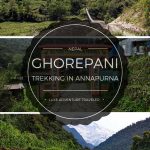

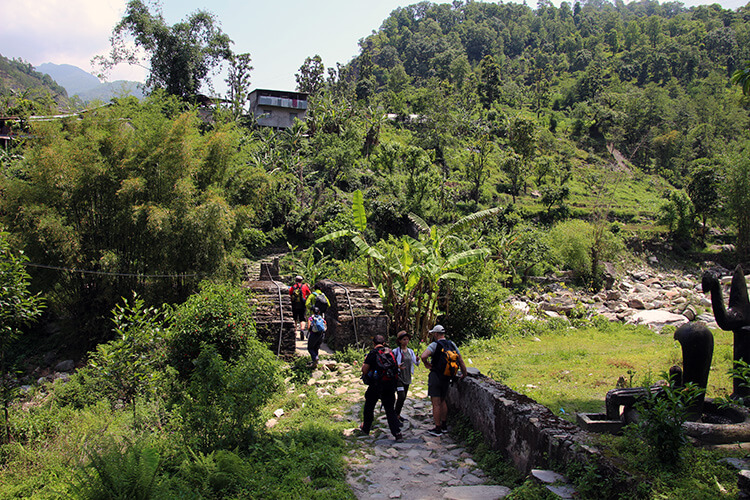
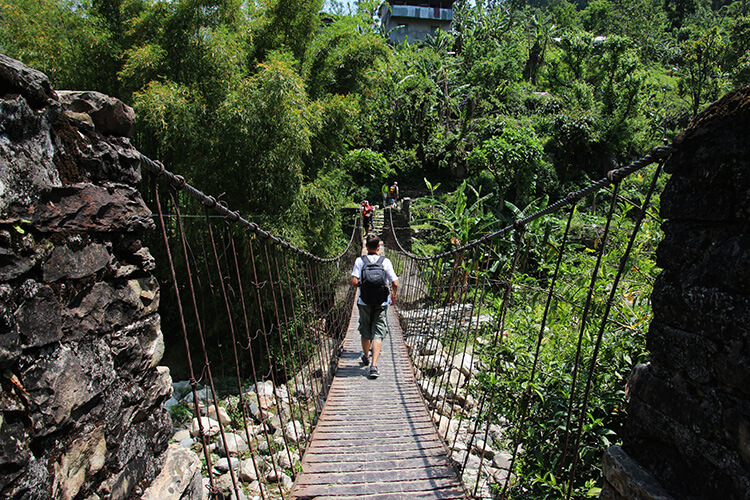
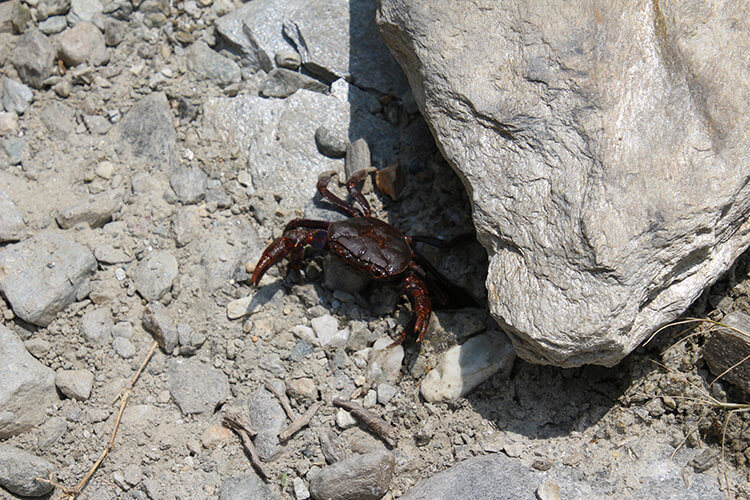
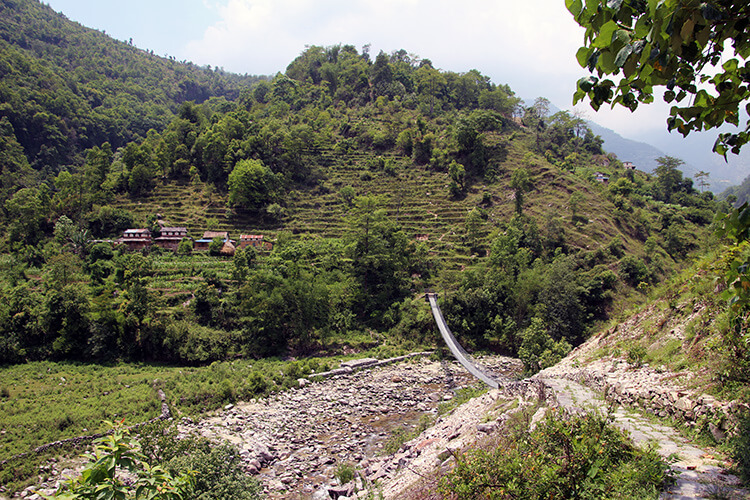
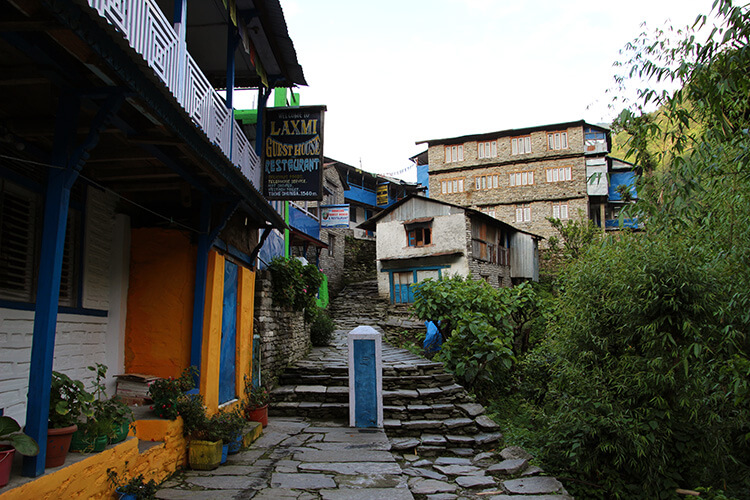

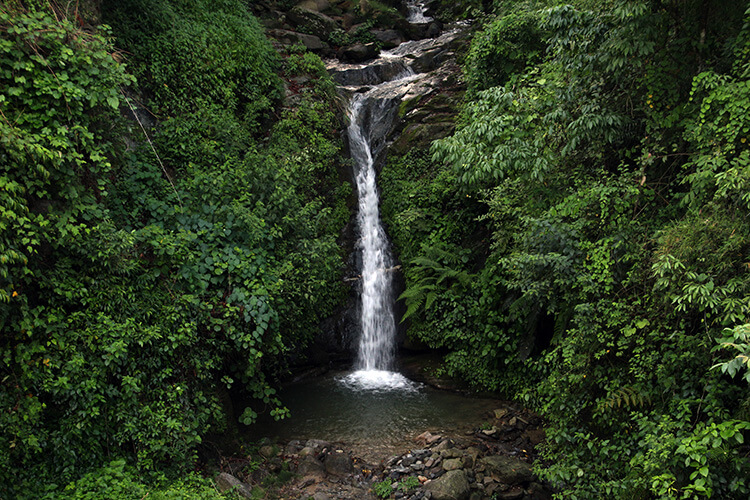
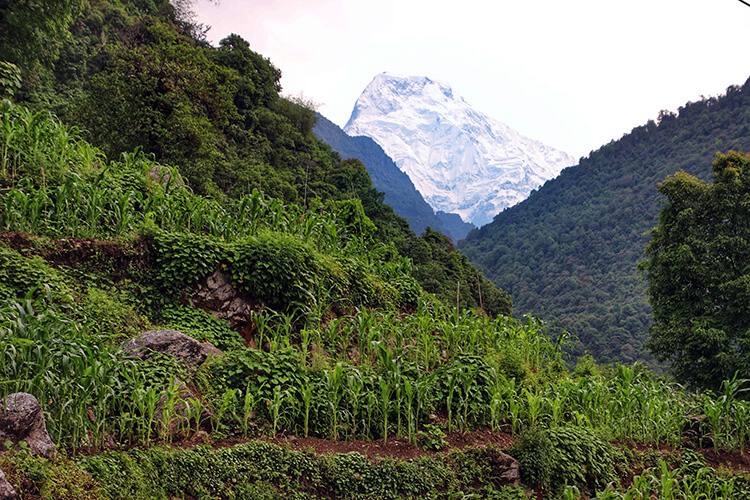
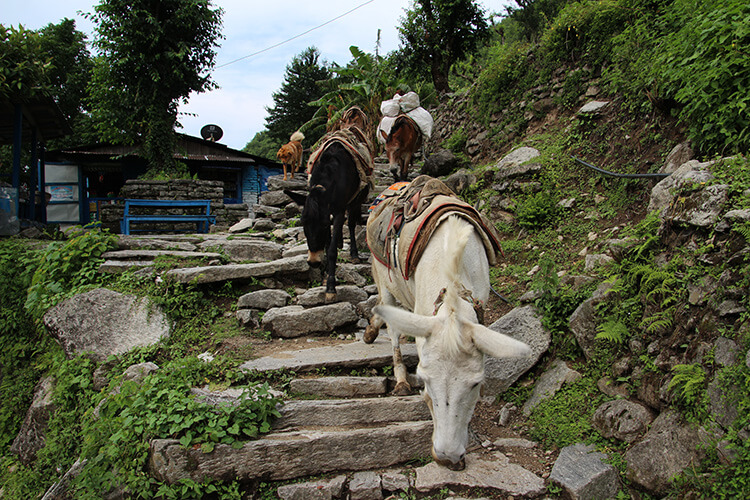
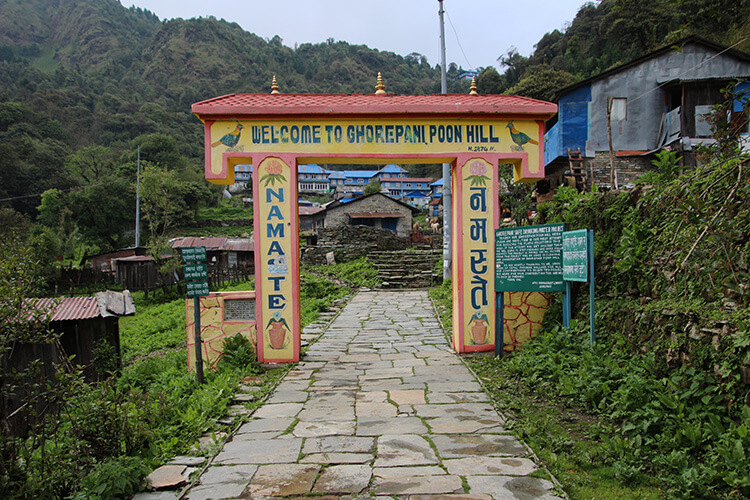
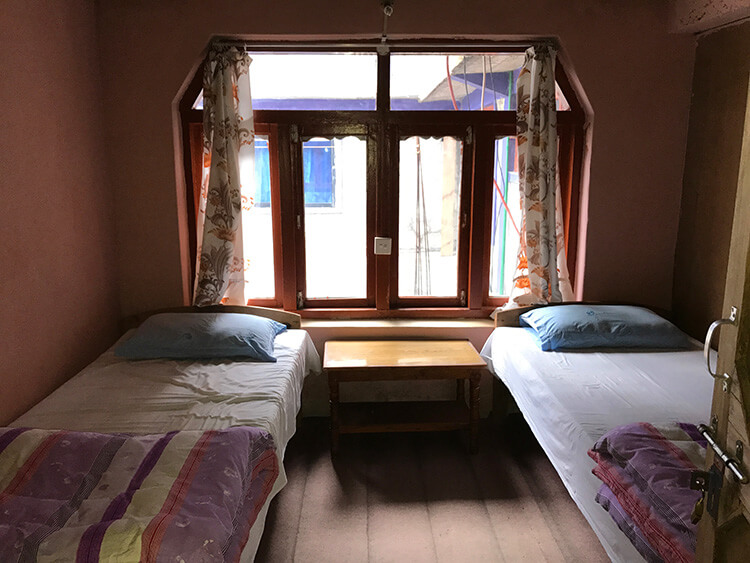
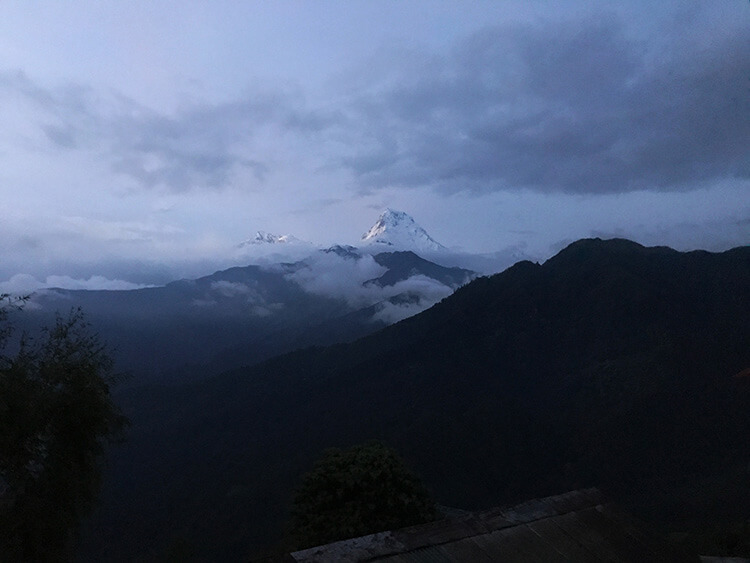
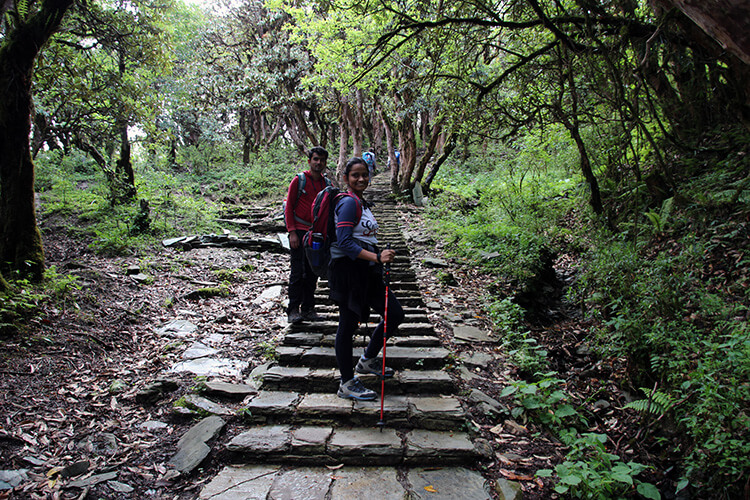

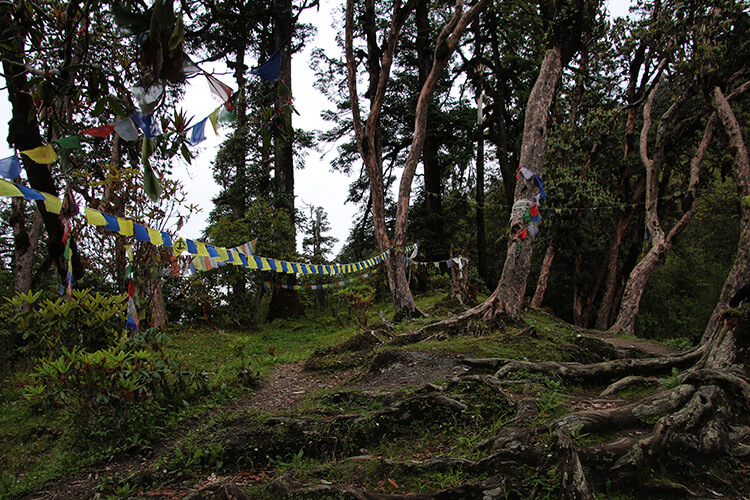
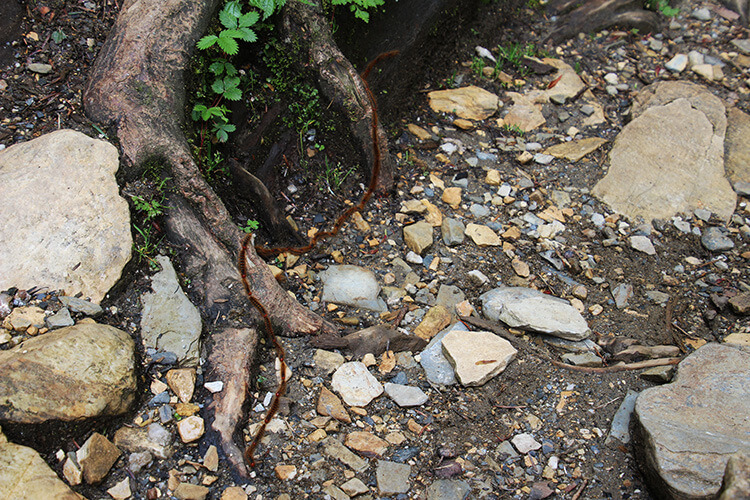
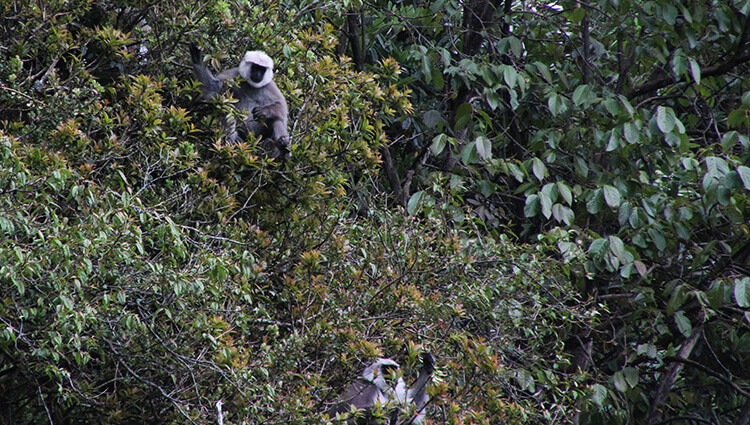
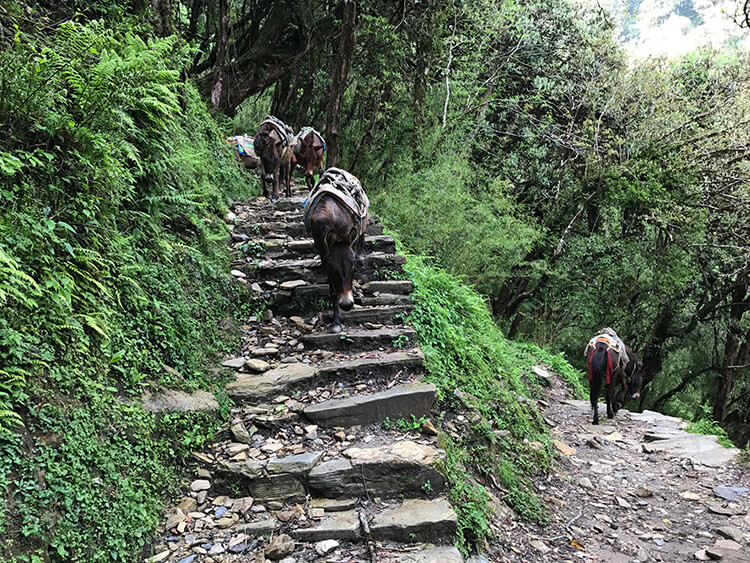
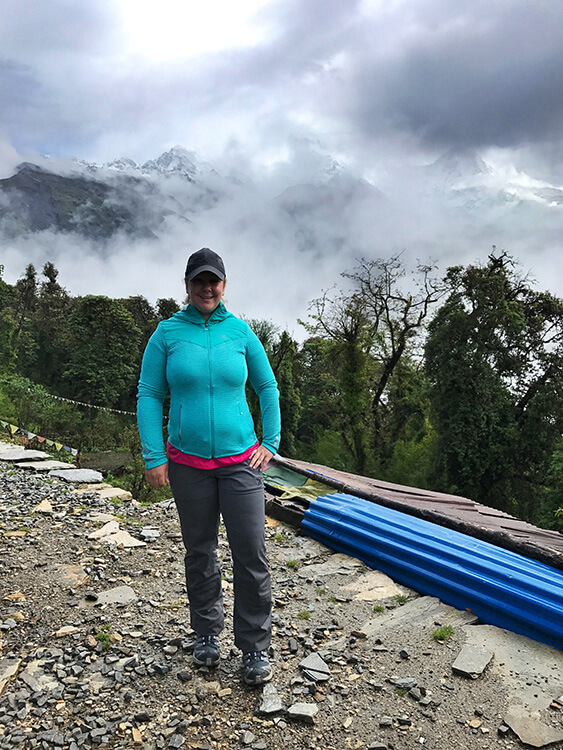
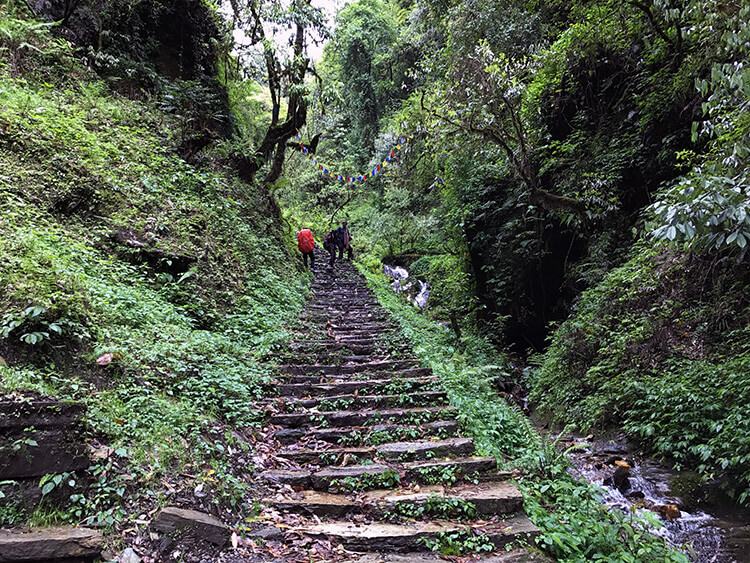
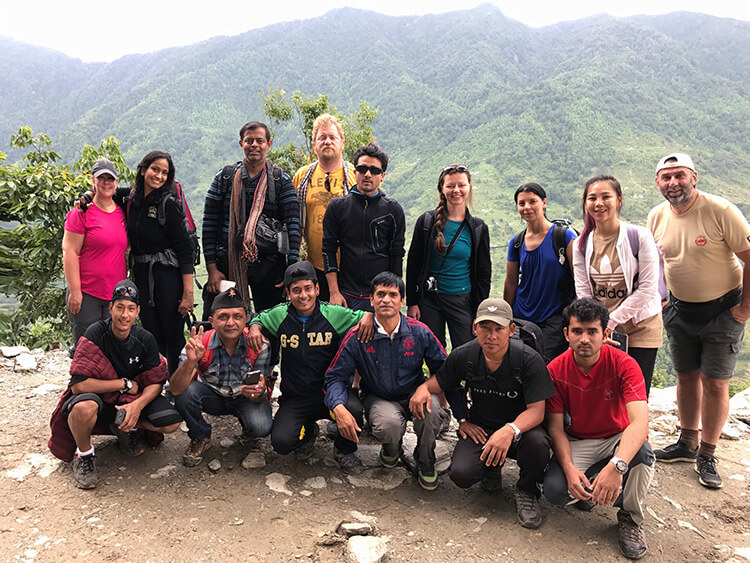
Kavey Favelle says
I’m so full of admiration at your determination and grit. To carry on through so much pain is so impressive. Now that you have some distance from that pain, do you feel the wonders you experiences make up for how hard and painful some of the trek was? Loved reading along with you and was really cheering you along at the end!
Mei says
Wow what a great experience! Thanks for sharing! This reminds me of the time when we were hiking through the rice terraces in Guilin. But of course that was another landscape and different temperatures. By the way, I must admit that I also thought that the temperatures in Nepal are always rather cold!
Fiona Maclean says
This is the kind of trip I hesitated to do when I was young enough and fit enough. Now I’d need a serious bootcamp first! Good for you – it looks amazing and I love the Langur monkeys
Claudia says
Ugh I am so sorry to hear about the blister ;/ but what an amazing experience overall and congratz on having such determination
Kim-Ling Richardson says
How funny and bizarre to see a crab! I\’ve never done a hike before, but it looks like a rewarding challenge. Your photos look amazing, especially the waterfalls and Annapurna in the distance. Well done on completing the trek!
Lois Alter Mark says
There is no way I could do this trek and I’m out of breath just reading this! Congrats on the accomplishment and go treat yourself to a full-day foot massage!
Elisa says
What a beautiful trek. I have never been to Nepal yet because I can take long holidays only in July and August, not the best season for Nepal. So happy to know there are some Nepal trekking alternatives for the European summer. I took note it can be hot so I will pack consequently 😉
Ryazan says
OMG!! I’m so jealous! I really wanted to do this trek. I’ve been dreaming of doing this for a few years now. I really have to make this happen.
noel says
Congrats for doing this trek and finishing – I was thinking about doing this, but I did a trek in California before this and didn’t want to have issues so I opted to do the culture tour. This looks like an experience I would love to do at least once.
Sandy N Vyjay says
What a lovely trek. The Ghorepani trek is really an exhilarating one. Love the landscapes along the way and also the immersive experience of passing through remote villages and interacting with the local people. The fact that you were in a large group would have added to the fun of the experience.
Abhinav Singh says
Lovely blog Jenifer. You summed it up so well. And thanks for the mention. I admired the way you continued with determination. Hope to trek again with you someday.
Ranjan Khadka says
Hi There!
Thank you so much for sharing your trekking experience. I like your blog. Appreciate it
STEVEN B BLACHER says
What time of year was your trek? Thank you Steve
Jennifer Dombrowski says
I did the Ghorepani trek in May.
Steve says
We have not gone yet. We are thinking of Oct / November this year with a trip into Bhutan also. And follow that with Poon Hill
Jennifer Dombrowski says
October/November is a great time for trekking in that region. Our local guides definitely recommended October for the best month.
Steve says
Hi, Over all how was your trip. Did you find it difficult other than the problems. How were the views given the weather. ?
Peter says
Jennifer and Tim,
Was reading your blog of your trek in Nepal. Did you booked this trek at a local agency in Pokhara ?? Could you please share the name if this is the case ??
Cheers,
Peter
Jennifer Dombrowski says
Hi Peter,
We trekked with Royal Mountain Nepal. https://royalmt.com.np/ All the details with what is included and what to expect for additional costs are in the ‘Know Before You Go’ section at the bottom of our article on the ‘Trekking Info’ tab. Hope that helps!
Prasan says
Thank you for your information Jennifer about Ghorepani Poon Hill Trek. Everyone must read this article before trekking into the foot hills of Annapurna. I am trek & tour guide from Nepal.
Angela says
So much background information to use in a write-up of an imaginary WALK along this route for my WALKING THE WORLD FOR MS Facebook page. Your descriptions are fantastic and so real. Thank you for it all – needless to say my \”WALK\” will be in the dry and clear, with perfect views all the way and I will focus on the ease of tackling the thousands of steps, as per yaks and mules!